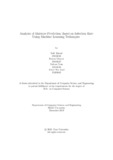| dc.contributor.advisor | Hossain, Muhammad Iqbal | |
| dc.contributor.author | Zawad, Safir | |
| dc.contributor.author | Mansur, Raiyan | |
| dc.contributor.author | Evan, Nahian | |
| dc.contributor.author | Asad, Ashub Bin | |
| dc.date.accessioned | 2020-10-12T05:52:02Z | |
| dc.date.available | 2020-10-12T05:52:02Z | |
| dc.date.copyright | 2019 | |
| dc.date.issued | 2019-12 | |
| dc.identifier.other | ID: 19241038 | |
| dc.identifier.other | ID: 19241037 | |
| dc.identifier.other | ID: 19241036 | |
| dc.identifier.other | ID: 15301062 | |
| dc.identifier.uri | http://hdl.handle.net/10361/14056 | |
| dc.description | This thesis is submitted in partial fulfillment of the requirements for the degree of Bachelor of Science in Computer Science, 2019. | en_US |
| dc.description | Cataloged from PDF version of thesis. | |
| dc.description | Includes bibliographical references (pages 22-23). | |
| dc.description.abstract | In this modern, technological age, the internet has been adopted by the masses. And
with it, the danger of malicious attacks by cybercriminals have increased. These
attacks are done via Malware, and have resulted in billions of dollars of financial
damage. Which is why prevention of malware attacks has become an essential part
of the battle against cybercrime. In recent years, Machine Learning has become an
important tool in the field of Malware Detection, which is the first step towards
removing malware from infected devices. In this thesis, we are applying machine
learning algorithms to predict the malware infection rates of computers based on its
features. We are using supervised machine learning algorithms and gradient boosting
algorithms, such as LightGBM, Neural Networks, and Decision Tree Learning. We
have collected a publicly available dataset, which was divided into two parts, one
being the training set, and the other will be the testing set. After conducting four
different experiments using the aforementioned algorithms, it has been discovered
that LightGBM is the best model with an AUC Score of 0.73926. | en_US |
| dc.description.statementofresponsibility | Safir Zawad | |
| dc.description.statementofresponsibility | Raiyan Mansur | |
| dc.description.statementofresponsibility | Nahian Evan | |
| dc.description.statementofresponsibility | Ashub Bin Asad | |
| dc.format.extent | 28 pages | |
| dc.language.iso | en_US | en_US |
| dc.publisher | Brac University | en_US |
| dc.rights | Brac University theses are protected by copyright. They may be viewed from this source for any purpose, but reproduction or distribution in any format is prohibited without written permission. | |
| dc.subject | Human learning techniques | en_US |
| dc.subject | Malware prediction | en_US |
| dc.subject | Neural Networks | en_US |
| dc.title | Analysis of malware prediction based on infection rate using machine learning techniques | en_US |
| dc.type | Thesis | en_US |
| dc.contributor.department | Department of Computer Science and Engineering, Brac University | |
| dc.description.degree | B. Computer Science | |

